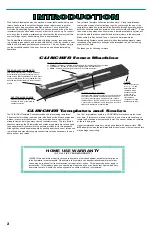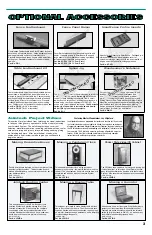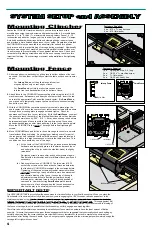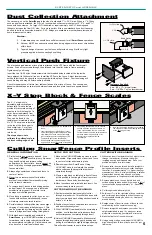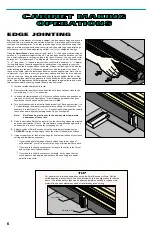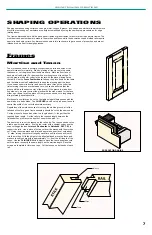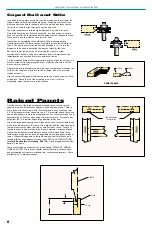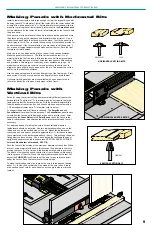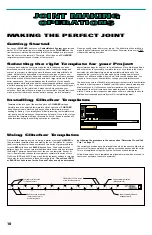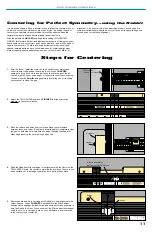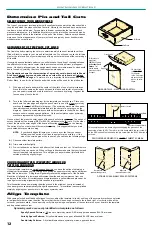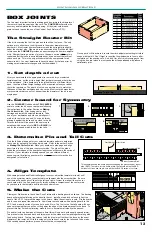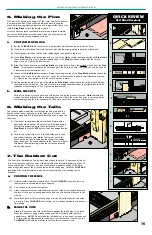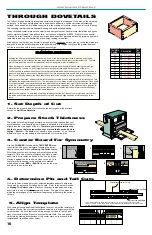
CLINCHER FENCE MACHINE.....................................................................................2
Templates and scales
Fence Machine Systems
Warranty
OPTIONAL ACCESSORIES.........................................................................................3
SYSTEM SETUP and ASSEMBLY ...............................................................................4
Mounting
CLINCHER
Mounting Fence
Dust Collection Attachment
Vertical Push Fixture assembly
X-Y Stop Block operation
Cutting Profile Inserts
EDGE JOINTING......... ................................................................................................6
SHAPING OPERATIONS .............................................................................................7
Frames
Raised Panels
MAKING THE PERFECT JOINT ................................................................................10
Getting Started
Selecting the right Template for your project
Installing and using
CLINCHER Templates
Centering for perfect symmetry - Using the
Rabbit ....................................11
Steps for centering
Determine Pin and Tail Cuts.......................................................................12
Template Alignment
BOX JOINTS................................ ..............................................................................13
Setting Depth of Cut for Box Joints
HALF-BLIND DOVETAILS ..........................................................................................14
Setting Depth of Cut for all Dovetail Joints
THROUGH DOVETAILS .............................................................................................16
DOUBLE DOVETAILS ................................................................................................18
DOUBLE-DOUBLE BOX JOINTS ...............................................................................20
BOXTAIL JOINTS......... ..............................................................................................22
THE MITER SPLINE JOINT .......................................................................................24
SLIDING DOVETAILS.................................................................................................24
REPETITIVE SCALE TEMPLATES.............................................................................24
•
When using a power tool with
CLINCHER,
follow the safety instructions in the tool’s
instruction manual. Use any safety guards
required for their safe use. Remember that all
power tools are inherently dangerous. Make
sure that you thoroughly understand their
operation and their safety features before you
use them.
•
Always wear safety glasses and hearing
protection when operation of power tools.
•
Always turn off power to any other tools prior to
any adjustment of
CLINCHER. Allow a cutting
tool to come to a complete stop before
repositioning of fence, sliding section or profile
insert.
•
If
CLINCHER is mounted to a moveable base,
always secure base to work surface by
clamping, screws, or otherwise fastened before
using.
•
Always tighten SmartFence sliding sections
clamping knobs before any cutting operation.
Avoid applying excessive force when clamping.
When using a profile insert, always securely
engage between both sliding sections.
•
Always align center of SmartFence to center of
router and cutter. Never use a cutter larger
than 4” in diameter nor greater than 2” in height,
including any bearing.
•
Before making a cut, always make sure that the
CLINCHER cam clamp is fully locked down and
machine setup is secure in place.
•
Whenever a cutting operation requires that your
hands come near or over a bit or blade,
ALWAYS USE A GOOD PUSH BLOCK or push
stick to protect your fingers.
•
Before performing any cutting operation,
carefully think it through. Anticipate any
situations that can be potentially dangerous,
such as: grabbing, kickback, splintering, or
exposed fingers, and take steps to insure that
they don’t happen.
S
SA
AF
FE
ET
TY
Y
-
-
R
RE
EA
AD
D
A
AL
LL
L
I
IN
NS
ST
TR
RU
UC
CT
TI
IO
ON
NS
S
Introduction
Setting Up
Cabinet Making
Operations
Joint Making
Operations



